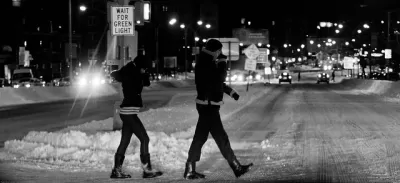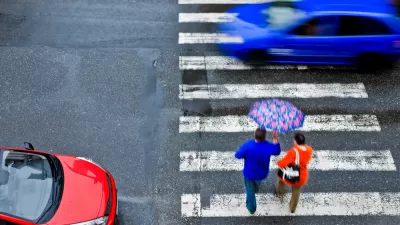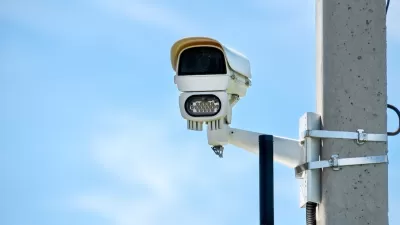The 300-foot wide Queens Boulevard has been known as the Boulevard of Death. Since 1990, it has claimed 186 lives, 74 percent being pedestrians, including 18 in 1997 alone. A series of safety improvements have brought fatalities to zero since 2014.

"The Boulevard of Death has become the Boulevard of Life,” declared Mayor Bill de Blasio in an interview with Winnie Hu, a reporter on The New York Times Metro desk, focusing on transportation and infrastructure.
Queens Boulevard has become the poster child for Mr. de Blasio’s ambitious Vision Zero campaign to eliminate traffic deaths citywide through a host of enforcement measures and safety improvements, including redesigning streets and re--timing walk signals to give pedestrians a head start in crosswalks.
“Queens Boulevard is the ultimate example of what was wrong in this city for decades,” he said. “I love my city but something was broken that we had a street called the Boulevard of Death and we accepted that."
To deal with the 12-lane, 300-foot width, the New York City Department of Transportation installed pedestrian countdown signals, increased the pedestrian crossing time, installed sidewalk bulb-outs, "widened medians and built protective barriers around them," adds Hu. "More crosswalks were added and fencing installed along the entire boulevard to deter jay walking."
Lanes were removed and reconfigured. Red light cameras were added. But six pedestrians died in 2013. De Blasio, who took office the next year, lowered the speed limit from 30 to 25 mph.
Since then, city transportation officials have invested $4 million to redesign the boulevard, including putting in bike lanes and more crosswalks and places for pedestrians to wait in the median while crossing, and redesigned car lanes to reduce conflicts between local and through traffic. They added cameras to catch speeding drivers near two schools.
The bike lanes were particularly noteworthy because they showed the commitment of the mayor toward remaking the Boulevard of Death for cyclists. He overrode the community board who had removed them during the planning process. Take a Streetfilm tour here with Ryan Russo from the NYC DOT.
The biggest changes are still to come to Queens Boulevard. In 2019, the city expects to begin a $255-million project that will add wide, tree-lined medians, benches and a continuous bike and walking path.
Vision Zero fatality update
Notwithstanding the success on Queens Boulevard, the city has a long ways to go in reducing traffic deaths to zero by 2024.
"After two years of major declines in New York City’s traffic deaths, the number of people killed in crashes dropped slightly last year [to 231] while pedestrian deaths rose," reported Emma G. Fitzsimmons on Jan. 10, 2017. "Pedestrian deaths, which accounted for the largest share of fatalities, increased last year to [148], from 139 in 2015."
"This year’s numbers are more promising, with 198 overall traffic deaths as of Nov. 21, or 11 fewer than the same time last year," reports Hu. "Of those, 92 involved pedestrians, or 41 fewer than the year before, while 19 involved cyclists, or two more than the year before."
Hat tip to Peter Flieg.
FULL STORY: No Longer New York City’s ‘Boulevard of Death’

Alabama: Trump Terminates Settlements for Black Communities Harmed By Raw Sewage
Trump deemed the landmark civil rights agreement “illegal DEI and environmental justice policy.”

Study: Maui’s Plan to Convert Vacation Rentals to Long-Term Housing Could Cause Nearly $1 Billion Economic Loss
The plan would reduce visitor accommodation by 25% resulting in 1,900 jobs lost.

Planetizen Federal Action Tracker
A weekly monitor of how Trump’s orders and actions are impacting planners and planning in America.

Wind Energy on the Rise Despite Federal Policy Reversal
The Trump administration is revoking federal support for renewable energy, but demand for new projects continues unabated.

Passengers Flock to Caltrain After Electrification
The new electric trains are running faster and more reliably, leading to strong ridership growth on the Bay Area rail system.

Texas Churches Rally Behind ‘Yes in God’s Back Yard’ Legislation
Religious leaders want the state to reduce zoning regulations to streamline leasing church-owned land to housing developers.
Urban Design for Planners 1: Software Tools
This six-course series explores essential urban design concepts using open source software and equips planners with the tools they need to participate fully in the urban design process.
Planning for Universal Design
Learn the tools for implementing Universal Design in planning regulations.
Caltrans
Smith Gee Studio
Institute for Housing and Urban Development Studies (IHS)
City of Grandview
Harvard GSD Executive Education
Toledo-Lucas County Plan Commissions
Salt Lake City
NYU Wagner Graduate School of Public Service





























